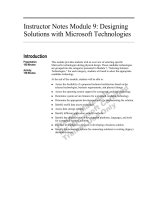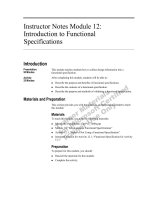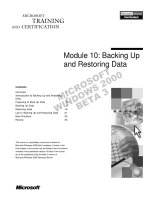Instructor Notes Module 10: Completing Physical Design
Bạn đang xem bản rút gọn của tài liệu. Xem và tải ngay bản đầy đủ của tài liệu tại đây (87.03 KB, 4 trang )
Instructor Notes Module 10:
Completing Physical Design
Introduction
This model teaches students to complete the last two steps of physical design:
rationalization and specification. Students learn how to develop a packaging
and deployment strategy and how to create deployment models.
After completing this module, students will be able to:
!
Complete the rationalization step of physical design.
!
Derive a physical design from a logical design.
!
Describe the deliverables of a physical design specification.
!
Describe a component specification.
Materials and Preparation
This section provides you with the materials and preparation needed to teach
this module.
Materials
To teach this module, you need the following materials:
!
Microsoft
®
PowerPoint
®
file P10_1608a.ppt
!
Module 10, “Completing Physical Design”
!
Activity 10.1, “Creating and Distributing Preliminary Components”
!
Activity 10.2, “Refining Preliminary Distribution for Performance”
!
Activity 10.3, “Factors Impacting the Programming Model”
Preparation
To prepare for this module, you should:
!
Read all the materials for this module.
!
Complete the activities.
Presentation:
75 Minutes
Activity:
60 Minutes
2 Instructor Notes Module 10: Completing Physical Design
Activities
Activity 10.1: Creating and Distributing Preliminary
Components
In this activity, students will place candidate components into service layers
assigned in a previous activity.
After completing this activity, students will be able to:
!
Create a preliminary component topology by distributing preliminary
components across the network topology.
!
To prepare for the activity
1. In case some students do not have their copies, prepare extra copies of the
Future Network Topology from the Ferguson and Bardell, Inc. case study,
the business object model created in Module 5, and the service layer
topology created in Module 6.
2. Complete the activity yourself.
3. Prepare some questions to foster a class discussion.
Activity 10.2: Refining Preliminary Distribution for
Performance
In this activity, students will reorganize their candidate components to account
for additional constraints or requirements.
After completing this activity, students will be able to:
!
Modify a component topology to meet other requirements.
!
To prepare for the activity
1. Complete the activity yourself.
Be prepared with examples to use as discussion starters in case any groups
get stuck on the last question.
2. Prepare some questions to foster a class discussion.
Instructor Notes Module 10: Completing Physical Design 3
Activity 10.3: Factors Impacting the Programming Model
In this exercise, based on the course material preceding this activity, students
will take part in a class discussion to identify what has the greatest impact on
determining a programming model.
After completing this activity, students will be able to:
!
Articulate some of the factors that impact how a team chooses and
implements a programming model.
!
To prepare for the activity
1. Think through the possible class discussion.
Prepare starter examples to aid the class during brainstorming.
2. Be sure you have enough flip-chart paper and working markers for the
discussion.
3. Prepare examples from your own experience.
4. Prepare some questions to foster a class discussion.
4 Instructor Notes Module 10: Completing Physical Design
Module Strategy
Use the following strategy to present this module:
!
Physical Design Rationalization
The focus of the rationalization step is on designing services-based
components and developing a distribution strategy for those components.
Continue to emphasize the iterative nature of design, including the
rationalization step.
By this point in the course, some students will be struggling with the
multitude of new terms and concepts they have learned. Keep them moving
forward, but be sensitive to the “brain fatigue” they may be experiencing.
As a motivating factor, remind them that they are only two steps from
completing their physical design.
!
Activity 10.1: Creating and Distributing Preliminary Components
This activity is in the section. The students will develop preliminary
components and distribute them based on the preliminary topology they
developed.
!
Activity 10.2: Refining Preliminary Distribution for Performance
Students should attempt to optimize the component distribution to achieve
maximum performance.
!
Physical Design Specification
In this section, students will learn about the final step in physical design:
specification, which includes determining the programming model and
documenting the component interfaces.
Emphasize the importance of completing this step so that the development
team has a complete specification from which to work. A well-conceived
programming model helps ensure standards throughout the development
project, and as a result, will actually save time later in the development
process.
!
Activity 10.3: Factors Impacting the Programming Model
In this discussion, you can gauge students understanding of both the
programming model and of the culmination of physical design.









